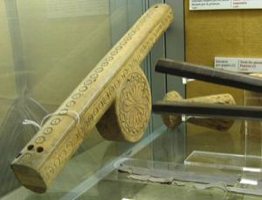The key, she says, lies in the numbers encoded in the object’s ornate decoration, which resembles a compass rose with 16 evenly spaced petals surrounded by a circular zigzag with 36 corners.
Sparavigna says that if the straight bar part of the object were laid on a slope, a plumb line would revealed its inclination on the circular dial.
The fraction of one-sixteenth features in a calculus system the Egyptians used, says Sparavigna, and they also identified 36 star groups called the decans, which later formed the basis of a star clock. She suggests the object was “a protractor instrument with two scales, one based on Egyptian fractions, the other based on decans”.
Wednesday, August 3, 2011
World’s oldest protractor?
This object was found more than a century ago in an Egyptian tomb belonging to an ancient architect who lived around 1400 BCE. In the Turin museum where it’s displayed, the artifact is identified as a decorative case for a balancing scale. However, physicist Amelia Sparavigna thinks it may be the oldest surviving protractor. From New Scientist:


No comments:
Post a Comment